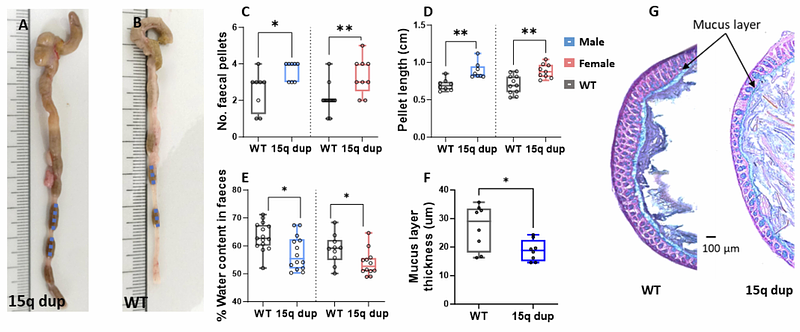Prucalopride ameliorates delayed gastrointestinal transit and social behaviour in a mouse model of 15q duplication syndrome

Prucalopride ameliorates delayed gastrointestinal transit and social behaviour in a mouse model of 15q duplication syndrome
Takumi, T.
AbstractIntroduction: Chromosome 15q duplication syndrome (Dup15q) is a neurodevelopmental disorder linked to autism spectrum disorder (ASD), involving increased copies of the 15q11.2-q13 region. About 80% of individuals with Dup15q experience gastrointestinal (GI) dysfunction, including constipation. The duplicated region encodes GABA receptor A subunits, affecting GABAergic signalling, while reduced serotonin (5-HT) levels impair neuronal activity and social behaviour in a mouse model of Dup15q (15q dup). Given the importance of GABA and serotonin in the enteric nervous system (ENS), this study investigates GI dysfunction and neurotransmission in a Dup15q mouse model. Methods: Colon RNA extracts were analysed for GABA receptor subunit and serotonin-associated gene expression using quantitative PCR. Total GI transit was assessed by Carmine red dye gavage. Ex vivo colonic motility was analysed via video imaging. The GABA receptor A antagonist Bicuculline was used to assess GABAergic signalling. Prucalopride, a 5-HT4 receptor (5HT4R) agonist, was administered for six days, and its effects on GI transit and social interaction were evaluated. Results: 15q dup mice exhibited elevated GABA receptor gene expression and reduced Tph2 and Htr4 expression in the colon. Total GI transit was delayed, and ex vivo colonic motility was slower and less extensive. Bicuculline further impaired colonic contractions, indicating enhanced GABAergic sensitivity. Prucalopride restored GI transit delays and improved social interaction, as evidenced by increased contact duration in social tests. Conclusion: Prucalopride effectively restores GI function and improves social behaviour in 15q dup mice, demonstrating its therapeutic potential for addressing both GI dysfunction and behavioural deficits in 15q duplication syndrome.